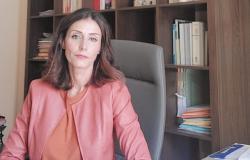On the evening of Wednesday 25 April 1945, the pediatrician Piero Fornara, an emblematic figure of anti-fascism who after the war would become prefect of Novara, left his house at number 15 in Piazza Cavour, walked up a flight of stairs and rang the doorbell of the house at upstairs. «I opened the door, but he was looking for my father. He told him “Umberto, go out on your bike tomorrow morning at 6 with two cameras and lots of film, you’ll have lots of shots to take”. Without knowing anything else, my father followed that advice, bringing his trusty Leica with him. Never would he have imagined immortalizing the day of the Liberation of Novara.”
Eugenio Bonzanini, president of the Faraggiana foundation and son of the photojournalist and painter, tells what happened on April 26th. Umberto Bonzanini. Who, at the first light of the morning of that April 26th, photographed the moment that represents the liberation of Novara: the meeting in the square of Veveri between the German colonel Hahn and the bishop Leone Giacomo Ossola, which unblocked the negotiation for the surrender of the Nazi-fascists. In fact, it was the monsignor who invited the Wehrmacht to remain in the barracks, the fascists not to leave their quarters, the partisans to avoid any violence. «My mother wanted to keep me at home that day because she thought it was dangerous to go out – recalls Eugenio, who was 6 and a half years old -. But I was a good little rascal, so as soon as she got distracted I ran out into the street to watch the partisans parade.” He waited for them in Corso Cavour, under Piero Fornara’s house where for about two years the Novara anti-fascists organized the Resistance. «I was in shorts and waving an Italian flag» he comments, pointing to a photo from the book «Il memoria e la vita», which collects the shots his father took in those days.
That volume, explains Eugenio, is all that remains of Umberto’s memory of that historic April: «After the war he wanted to destroy all the negatives. I never knew the real reason. I tried to ask a few times, but he never wanted to come back to the subject.” What she keeps, therefore, are the anecdotes she experienced when she was still in elementary school: «My father had been in business since 1926 and naturally did several shoots during the twenty years, he was called to immortalize the rallies. But he never wanted to wear the fascist uniform: after the war, his black shirt became a pair of trousers for me. Sometimes he even falsified shots of various rallies. For example, he took a panoramic photo, then in the laboratory he multiplied the people using painting techniques. The federal officer on duty, not realizing the trick, paid him enthusiastically and my father, in this way, could escape from the fascists’ orders sooner.”
As a photojournalist, Eugenio continues, «he often went around the farms and thus managed to bring us rice, milk, potatoes. In those days we didn’t starve, but it often happened that we went to bed with only warm milk in our stomach.” He also remembers the arrival of the Americans with emotion: «They were in a camp in the Children’s Park and gave the little ones sweets. We had never seen or tasted them, it was a sensational discovery.”
Among Umberto’s famous shots, his son Eugenio focuses his mind on that of Sunday 29 April 1945: the hanging corpses of Benito Mussolini and Claretta Petacci in Milan. «We were going to visit my grandmother – she says – and there was incredible chaos outside the station. After finding out what was happening, he rushed to Piazzale Loreto to immortalise everything.”






